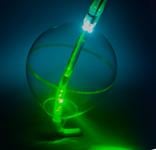
September 18, 2009 – Physicians at The Mount Sinai Medical Center in New York became the first in the U.S. to ablate atrial fibrillation (AF) using a visually-guided laser balloon catheter.
The procedure was performed Sept. 15 by Vivek Y. Reddy, M.D., professor of medicine and director of the cardiac arrhythmia service at Mount Sinai Heart, and his colleague, Srinivas R. Dukkipati, M.D., director of Mount Sinai’s experimental electrophysiology laboratory. The procedure marks the first time the device – the Endoscopic Ablation System manufactured by CardioFocus Inc. – has been used in human clinical trials in this country. Dr. Reddy is the principal investigator for the national study.
Approximately 6 million U.S. adults have been diagnosed with AF, a condition characterized by a rapid and irregular heartbeat that can cause serious complications, including stroke, palpitations, fainting and early death. AF diagnosis has increased over the past two decades and the condition now accounts for one-quarter of all strokes in the elderly.
“This new device has the potential to make AFib ablation more reliable, more reproducible, and more consistent for patients with paroxysmal [intermittent] atrial fibrillation,” said Dr. Reddy. “The technology which is currently available leads to widely variable success rates, depending largely on physician skill and experience with the procedure. This visually-guided system with a rotating laser design has the potential to simplify AFib ablation and make it available to more patients than ever, before their paroxysmal AFib becomes chronic AFib.”
Valentin Fuster, M.D., director of Mount Sinai Heart and chair of the European American Guidelines on AF, said, ”Such an advance in the treatment of atrial fibrillation is another small step forward to cure the disease without the need for chronic medication.”
Paroxysmal AF is caused by irregular electrical signals that come from pulmonary veins that drain blood from the lungs to the heart. During a standard AF ablation procedure, physicians use spot catheters to cauterize heart tissue in a point-by-point manner to encircle these pulmonary veins; this creates a ring of scar tissue to electrically isolate the pulmonary veins, thereby preventing the irregular electrical signals from causing AF. But this is a technically complicated procedure since unlike open heart surgery, physicians cannot directly see the tissue that is being cauterized. Despite using various cardiac mapping systems, problems often arise because the scar tissue that is created is not continuous, allowing the abnormal electrical signals to continue to pass into the heart and cause recurrence of AF.
The new balloon catheter device used by the Mount Sinai Heart team features a built-in camera that allows the physicians to directly see the heart tissue that needs to be ablated. They can then guide an internal laser in a continuous arc around the origin of the vein, creating more uniform scar tissue. “By directly seeing the tissue that we are ablating, there is less chance of a gap in the encircling ablation line,” said Dr. Dukkipati.
The patient was a 58-year-old man with a history of paroxysmal AF. He had been treated with a number of drugs, which failed to control the AF, so he continued to have symptoms including palpitations, and shortness of breath. Therefore, he elected to undergo a catheter ablation procedure to eliminate his symptoms. The procedure was performed in a cardiac catheterization laboratory and did not require surgery or cardiopulmonary bypass.
Dr. Vivek Reddy, the principal investigator on this study, receives financial compensation for conducting training cases from CardioFocus Inc., the study sponsor.
For more information: www.mountsinai.org, www.cardiofocus.com


 April 24, 2024
April 24, 2024 








